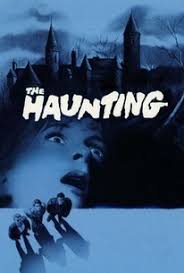
Hill House was built by Hugh Crain in a remote part of New England. The huge mansion was a gift for his wife, but she never saw it. The horses on her carriage bolted and the carriage crashed against a tree killing the young wife. Crain moved into the house with his small daughter Abigail. Crain married again but his second wife died falling down a flight of stairs. Crain went to England leaving Abigail in the care of a nurse. He died in a drowning accident.
Abigail grew up and then grew old. Her nursery became her bedroom and then her sick room. In her old age she became an invalid. She hired a companion to take care of her. Abigail died calling her while the companion was messing around with a farm hand. The companion inherited the house and lived there alone. Everyone thought she killed Abigail. Eventually the companion went mad and killed herself. The house passed to a distant relative, Mrs. Sanderson (Fay Compton).
Having heard of the house’s reputation of being haunted Dr. John Markway (Richard Johnson) wants to rent the house for a couple weeks to investigate it. John is doing research on paranormal activity. He plans on having some select people work with him. Mrs. Sanderson requests that her nephew Luke (Russ Tamblyn) join the group. John has invited six others to join the investigation. Only two show up. They are Theodora (Claire Bloom) and Eleanor Lance (Julie Harris). Theodora is psychic. Eleanor, on the other hand, experienced a poltergeist event when she was a child. Eleanor is also high strung and a bit guilt ridden having recently lost her invalid mother.
No sooner do the group settle in when the strange noises start. Everyone picks up on the unusual activity but it seems to affect Eleanor more than any of the others. Outside the nursery is a cold spot. John believes it is the heart of the evil in the house. The next day, written on a hallway wall are the words “Help Eleanor Come Home”. Eleanor begins to believe that the house wants her. She eventually comes to believe that she belongs in the house and she understands that the house will never let her go.
“The Haunting” was released in 1963 and was directed by Robert Wise. It is a British horror and psychological thriller. The film was based on the book “The Haunting of Hill House” written in 1959 by Shirley Jackson.
Psychological thrillers seem to work best when they’re black and white movies. It gives the film a gothic noir flavor. In “The Haunting” the cinematography and the lighting add a lot more creep to the movie and highlight everyday items making them seem unearthly. There is no blood and no violence in the film. There is no physical manifestation in it either. It’s all sound and suggestion and a slow paced Hitchcockian building of tension. But it’s one of the scariest movies ever.
The cinematography, editing, sound and special effects are top notch. One of the effects was a scene where a supernatural force pushes against a large door bending it inward several times. The door was actually laminated wood. The buckling was achieved by having a strong crew member push a piece of timber hard against it from the other side. Another was a collapsing staircase effect. The staircase was designed by a metalworker at the Borehamwood studios. The effect was created by tying portions of the steps and railing to a cable that ran inside the staircase's central support column. When the cable was slackened, the stairway loosened up and moved freely. Then when the cable was tightened, the staircase appeared solid and stable. Director Robert Wise had to walk up the staircase to convince the actors that it was solid and would hold them.
The character of Theo is subtly played by Claire Bloom as a lesbian. The censors were aware of the subtext and demanded that Theo and Eleanor not touch in any of their scenes. They of course did. The film is one of the few Hollywood motion pictures of the sixties to depict a lesbian as feminine and not predatory.
The house exterior shots are of a real house. Ettington Park, now Ettington Park Hotel in Warwickshire, England, was used to represent Hill House. Supposedly it’s a real haunted house. The interior sets were constructed and shot at the MGM-British Studios in Borehamwood, Hertfordshire.

